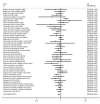Long-term coffee consumption and risk of cardiovascular disease: a systematic review and a dose-response meta-analysis of prospective cohort studies
- PMID: 24201300
- PMCID: PMC3945962
- DOI: 10.1161/CIRCULATIONAHA.113.005925
Long-term coffee consumption and risk of cardiovascular disease: a systematic review and a dose-response meta-analysis of prospective cohort studies
Abstract
Background: Considerable controversy exists on the association between coffee consumption and cardiovascular disease (CVD) risk. A meta-analysis was performed to assess the dose-response relationship of long-term coffee consumption with CVD risk.
Methods and results: PubMed and EMBASE were searched for prospective cohort studies of the relationship between coffee consumption and CVD risk, which included coronary heart disease, stroke, heart failure, and CVD mortality. Thirty-six studies were included with 1 279 804 participants and 36 352 CVD cases. A nonlinear relationship of coffee consumption with CVD risk was identified (P for heterogeneity=0.09, P for trend <0.001, P for nonlinearity <0.001). Compared with the lowest category of coffee consumption (median, 0 cups per day), the relative risk of CVD was 0.95 (95% confidence interval, 0.87-1.03) for the highest category (median, 5 cups per day) category, 0.85 (95% confidence interval, 0.80-0.90) for the second highest category (median, 3.5 cups per day), and 0.89 (95% confidence interval, 0.84-0.94) for the third highest category (median, 1.5 cups per day). Looking at separate outcomes, coffee consumption was nonlinearly associated with both coronary heart disease (P for heterogeneity=0.001, P for trend <0.001, P for nonlinearity <0.001) and stroke (P for heterogeneity=0.07, P for trend <0.001, P for nonlinearity <0.001; P for trend differences >0.05) risks.
Conclusions: A nonlinear association between coffee consumption and CVD risk was observed in this meta-analysis. Moderate coffee consumption was inversely significantly associated with CVD risk, with the lowest CVD risk at 3 to 5 cups per day, and heavy coffee consumption was not associated with elevated CVD risk.
Keywords: cardiovascular diseases; coffee; meta-analysis.
Figures








References
-
- Paul O, Lepper MH, Phelan WH, Dupertuis GW, Macmillan A, Mc KH, Park H. A longitudinal study of coronary heart disease. Circulation. 1963;28:20–31. - PubMed
-
- Robertson D, Frolich JC, Carr RK, Watson JT, Hollifield JW, Shand DG, Oates JA. Effects of caffeine on plasma renin activity, catecholamines and blood pressure. N Engl J Med. 1978;298:181–186. - PubMed
-
- Dobmeyer DJ, Stine RA, Leier CV, Greenberg R, Schaal SF. The arrhythmogenic effects of caffeine in human beings. N Engl J Med. 1983;308:814–816. - PubMed
-
- Thelle DS, Heyden S, Fodor JG. Coffee and cholesterol in epidemiological and experimental studies. Atherosclerosis. 1987;67:97–103. - PubMed
-
- Bak AA, Grobbee DE. The effect on serum cholesterol levels of coffee brewed by filtering or boiling. N Engl J Med. 1989;321:1432–1437. - PubMed
Publication types
MeSH terms
Substances
Grants and funding
LinkOut - more resources
Full Text Sources
Other Literature Sources
Medical

